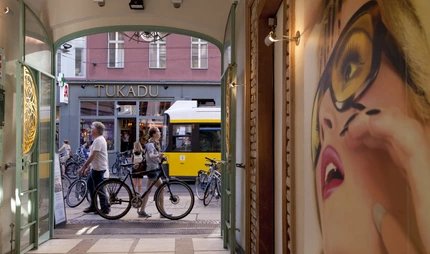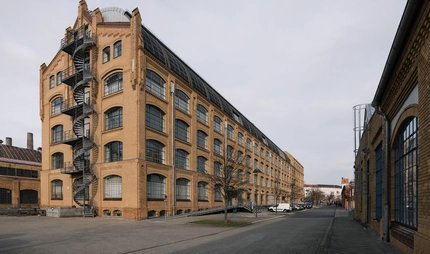
Shell-Haus
Waves of stone
The architect Meinhard von Gerkan called the Shell-Haus by the Landwehr Canal “Berlin's most beautiful building”
The Shell-Haus takes its name from the oil company of the same name. In the late 1920s, its German subsidiary Rhenania-Ossag Mineralölwerke AG needed a new office building in Berlin. And they wanted it to make an impression on the cityscape.
The competition was won by Emil Fahrenkamp. Actually, the architect was not someone noted for unusual concepts. He was in his mid-40s, a professor at the Düsseldorf Academy of Art and, above all, conservative in his designs. But the Shell-Haus that was built between 1930 and 1932 turned out to be his masterpiece.
Not too smooth
The Shell-Haus was unique in its form, construction and materials. Fahrenkamp created the dynamics of a wave – with a series of undulating projections along its windowed façade, adding another storey each time. Its rounded corners and windows enhanced the wave effect.
To create this unusual form, the architect used a state-of-the-art construction method. The six- to ten-storey Shell-Haus was one of the first steel-framed high-rise buildings in Berlin. The external cladding was made of travertine, a pale limestone from a quarry near Rome. Fahrenkamp also used high-quality materials for its windows, with frames made of steel and bronze.
To protect the Shell-Haus from the vibrations caused by increasing road traffic, the civil engineer Gerhard Mensch designed a special reinforced concrete tank for the steel frame to rest on. It extended far below ground level and its side walls were separated by a gap from the components above. In this way, hardly any vibrations penetrated the building with its trapezoidal ground plan.
Although the Shell-Haus was stylistically reminiscent of New Objectivity, Fahrenkamp didn’t completely put the function of the building before its form. The curves of the elegantly undulating façade made some of the floor plans of the offices rather impractical.
An expensive legacy
During the fierce fighting in the final days of the Second World War, the upper storeys were badly damaged. After the war, the Shell Group sold the derelict building to Bewag, the West Berlin electricity board, which repaired all the damage and moved its headquarters into the building.
The Shell-Haus became a listed building in 1958, and was painstakingly refurbished in the 1990s. To replace the damaged travertine on the exterior façade, the owners even had work resume at the long-closed quarry near Rome.
In 2000, Bewag sold the newly renovated Shell-Haus to a real estate company. Since then, the building in the Tiergarten district has had various tenants. First it was the headquarters of the Berlin gas supplier GASAG and since 2012 it has been an office of the Federal Ministry of Defence.
Our tips for the Shell-Haus
Very close to the Shell-Haus is the Kulturforum am Potsdamer Platz with other landmarks of Berlin Modernism. If you walk west along the Landwehr Canal instead, you’ll find the Bauhaus Archive and Museum of Design. The museum is currently closed.
Practical information from visitBerlin
You can get to the Shell-Haus on the M29 bus, getting off at the Gedenkstätte Deutscher Widerstand stop. The underground stations Mendelssohn-Bartholdy-Park (U2) and Kurfürstenstraße (U1) are both a kilometre away. To explore the city by public transport, we recommend the Berlin WelcomeCard.



